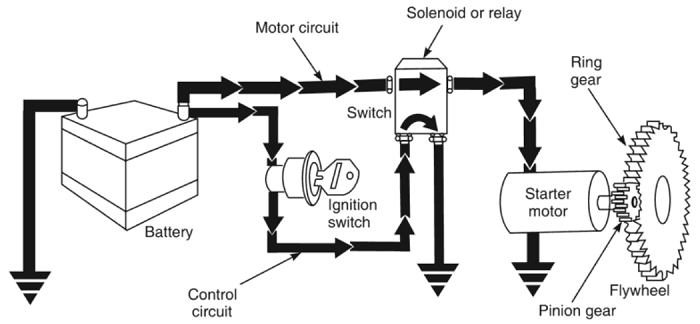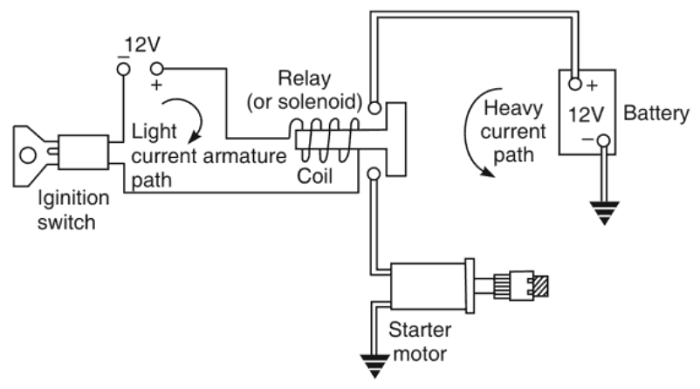The Starting System is an important part in a modern automobile (car, motorbike, truck, etc.). It helps you start your car’s engine with the push of a button or turn of a key. The overall starting system of a car is fairly simple with a handful of essential components. But even with simple designs, there is a possibility of failure and result in a bad starter. If this happens to you, then there is no need to panic as there are some workarounds to this problem. In this guide, we will understand some basics of a car’s starting system, see some possible problems and also how to start a car with a bad starter.
Outline
ToggleAn Overview of Starting System
Internal Combustion Engines (ICE) are not self-starting. If you remember, the early automobiles had a hand crank system. But as engines became larger and powerful, hand cranking became a safety issue and this gave birth to Automatic Engine Starting Systems.
The job of any Starting System, be it a manual hand crank one or a motor assisted automatic one, is to turn or crank the engine to begin the combustion cycle so that it can run on its own. To crank the engine, a Starter Motor spins the flywheel and as a result, it turns the engine’s crankshaft (hence the term cranking the engine).
During this time, other systems such as fuel and ignition supply fuel and sparks and within no time, the engine starts and operates on its own power.
Parts of a Starting System
Irrespective of the type of car, we can divide the starting system of a car into two circuits and six components. The circuits are:
- High-Amperage Motor Drive Circuit
- Low-Amperage Control Circuit
Coming to the components, they are:
- Battery
- Battery Cables
- Ignition Switch
- Safety Switch
- Solenoid or Relay
- Starter Motor
How a Starter Works?
Let us briefly take a look at how a typical car starting system works by understanding the job of each of the above component. The battery provides the energy to rotate the starter motor, which essentially cranks the engine.
You may be wondering, why we mentioned battery cables in the list of components and what’s so special about them? Battery cables here means the cables that carry current from the battery to the starter motor. During cranking, the starter motor draws very large current, usually more than 250Amps. If we don’t use proper cables to support this current, it could easily lead to fire or other damage.
The ignition switch is nothing but the driver’s key that we turn to start the car. Internally, it acts as a momentary switch to operate the solenoid or relay. A relay, if you are familiar with its working, is a type of switch where a tiny current controls a magnetic actuator that opens or closes contacts for carrying large currents.
Coming to the star of the show, the Starter Motor, it is a small but powerful electric motor. Most Starter Motors are usually brushed DC Motors. The drive shaft of the motor has a small gear known as Pinion Gear, which engages a large gear on the flywheel.
When we insert the key and turn it to ‘START’ position, the ignition switch supplies a small current to the relay/solenoid. This part of the circuit is known as the Control Circuit.
This tiny current will activate the relay/solenoid and closes contacts between the battery’s positive terminal and positive terminal of the starter motor. This circuit is known as the Motor Drive Circuit. If everything goes well, the starter motor rotates and engages the flywheel, which in turn rotates the crank shaft.
During this time, the fuel and ignition system come into play to supply fuel and spark to start the combustion and essentially start the engine.
Problems of a Bad Starter
The reason we learned about the starter system before looking at how to start a car with a bad starter is that if we are familiar with all the components and working of a system, then we can identify the potential problem each component/circuit can cause and we can diagnose the issue in a step-by-step manner.
That said, a ‘Bad Starter’ could mean anything from a fully discharged battery, faulty switches/relays/solenoids, blown fuse, bad motor, broken gears or bad wiring (including ground wiring).
Here are some common problems associated with a bad starter motor:
- The Starter doesn’t turn at all.
- It turns but very slowly.
- Starter Motor turns but the crankshaft doesn’t turn.
- Solenoid of the starter motor makes ‘clicking’ sound but it doesn’t crank the engine.
These are just some possible problems with a bad starter motor. Like this, a bad starter could mean problems with other components as well.
How to Start a Car with a Bad Starter?
You got up early, put-on iron-pressed clothes, had your breakfast and are ready to go to office for your big presentation. You take out your car keys, insert them into the slot, turn them but the car won’t start. Don’t panic if you have a bad starter as we will see how to start a car with a bad starter.
Jump Start Your Car
One of the main reasons for a car not to start is a deeply discharged battery. You might have not taken your car for few days or your car battery is very old or you used the car’s electricals (radio, lights) on battery. Whatever may be the reason, if your battery cannot supply enough juice to the starter motor, it cannot crank the engine.
You can jump start your car in such situations. There are a couple of ways to jump start a car but before looking at them, here is a safety tip. Open the hood/bonnet of your car and locate the battery. If there is any leak near it or if the battery looks bloated (bulging), it is time to call a professional as you have to replace the battery.
But if everything looks good, then you can jump start the car by using another car’s battery. If you have two cars, then you don’t have ask for anyone’s help. But if you don’t have the extra car in your garage, then call your friend or neighbor and ask them to help boost your car.
First, let your friend’s car cool down slightly to access the hood. Park your cars facing each other and open the hoods of both the cars. Now get a pair of good quality jumper cables (red and black) and connect one end of the red wire (positive) to the positive terminal of your friend’s car battery and the other end to your car battery’s positive terminal.
Take the black wire and connect one end to the negative terminal of your friend’s car battery and the other end to any grounding point of your car (any unpainted metal, away from the battery and fuel).
Start you friend’s car and let it run for at least a minute. Now, start your car. If the problem with your starter is just a discharged battery, then the car will start immediately. Continue idling both the cars for 10 minutes before disconnecting the cables.
Speaking of disconnecting you have to follow a reverse order i.e., turn off both the car and first remove the black wire from your car. Then remove the black wire from your friend’s car. Same with the red wire, first from your car and then lastly from your friend’s car. At any point of this job, make sure that you do not contact the leads of the jumper cables, whether you are connecting them or disconnecting them.
As we said before there are a couple of ways to jump start your car. The second method is using those fancy Portable Jump Starters. They are tiny devices that contain li-ion batteries that will help you jump start your car. You have to follow the same connecting and disconnecting steps.
Push Start / Bump Start Your Car
If you have a manual transmission car, then we can go old school and push start or bump start your car. But you need help from couple of people to push the car.
Turn on the ignition and put the car in second gear. Continue depressing the clutch and get someone to push the car to attain about 10mph. at this speed, release the clutch pedal and if everything goes well, your car will start. If not, you can try couple more times.
What to do if the Car Won’t Start?
If your car won’t start even after attempting both the previous methods, then the problem may be with other systems of the starter. Here are some possible troubleshooting tips.
- One of the main starter problems is bad connection between the battery and the starter motor. A red wire from the battery’s positive terminal goes to the starter motor (another one forks to alternator). Check if this cable has good connection or not.
- All the exposed metal parts if a car act as grounding points. In fact, this is one of the main problems with starter system i.e., a bad connection between the starter motor and the grounding point. Check this connection for any rust, damage or loose wiring.
- You can dig deeper and look for teeth on the pinion gear and also the ring gear of the flywheel. Damaged or missing teeth will prevent the starter motor from engaging the gears together.
- Starter Motor’s solenoid can also cause problems. You can directly run the solenoid using 12V and see whether it is making clicking sounds or not.
NOTE: We recommend you not to mess with any of the car’s components or electricals if you are not familiar with them. After failing to start the car by jump starting or push starting, it is better to contact a mechanic.
Conclusion
Nobody wants to start their work day with a bad starter. But this is one of the common problems with cars due to a number of reasons such as discharged battery, broken teeth of gears, blown fuse, burnt starter motor to name a few. In this guide, we saw about a typical starting system of a car, its components and working. We also saw a couple of solutions on how to start a car with a bad starter.



